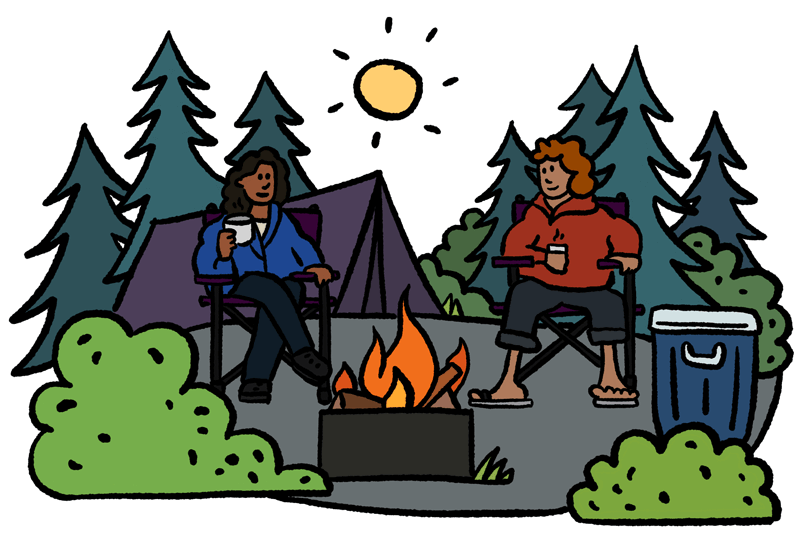Dry River Camping
notifications Text me when there's a cancellation at Dry River Campground

The White Mountain National Forest (WMNF) is a federally managed forest contained within the White Mountains in the northeastern United States. It was established in 1918 as a result of the Weeks Act of 1911; federal acquisition of land had already begun in 1914. It has a total area of 750,852 acres (303,859 ha) (1,225 sq mi). Most of the WMNF is in New Hampshire; a small part (about 5.65% of the forest) is in the neighboring state of Maine. Conservationist and community activist Katherine Sleeper Walden was instrumental in securing at-risk land for the forest, including thousands of acres in the region surrounding the locally famous Bowl near Wonalancet.
While sometimes called a park, it is a national forest, used for logging and other limited commercial purposes in addition to recreational activities. The WMNF is the only national forest located in either New Hampshire or Maine, and is the most eastern national forest in the United States. Most of the major peaks over 4,000 feet high in New Hampshire are located in the national forest. Over 100 miles (160 km) of the Appalachian Trail traverses the White Mountain National Forest. In descending order of land area the forest lies in parts of Grafton, Coos, and Carroll counties in New Hampshire, and Oxford County in Maine.
The Forest Supervisor's office is located in Campton and there are three ranger districts: the Pemigewasset District, with offices in Campton; the Androscoggin District, based in Gorham; and the Saco District, based in Conway. Furthermore, there are several visitor centers, including those located at Lincoln, Campton (off Interstate 93), and Lincoln Woods (on the Kancamagus Highway).
The White Mountain National Forest consists of three discontinuous areas, separated by two highways: I-93 and US 2. I-93 travels along Franconia Notch (a narrow north–south valley primarily within a state park), and west of the freeway includes Cannon Mountain, Kinsman Mountain and Mount Moosilauke (though the majority of Moosilauke is privately owned). East of I-93 is the largest section of the Forest, including the Presidential Range and many other ranges - most notably, the Franconia, Twin, Bond, Sandwich, Willey, and Carter-Moriah ranges. North of U.S. Route 2 is the smallest section of the National Forest, covering the Pilot Range and Mount Cabot. Additionally, several other U.S. and NH State highways cross the forest, including US 3, US 302, NH 16 (White Mountain Highway), NH 112 (Kancamagus Highway), and NH 118 (Sawyer Highway).
It is home to wildlife species including bald eagle, raccoon, beaver, white-tailed deer, moose, black bear, coyote, peregrine falcon, Canadian lynx, river otter, bobcat, gray and red foxes, fisher, mink and porcupine.
Six designated Federal Wilderness Areas exist within the Forest: the 27,380-acre (11,080 ha) Presidential Range/Dry River Wilderness, the 5,552-acre (2,247 ha) Great Gulf Wilderness, the 45,000-acre (18,000 ha) Pemigewasset Wilderness, the 35,800-acre (14,500 ha) Sandwich Range Wilderness, the 12,000-acre (4,900 ha) Caribou/Speckled Mountain Wilderness, and the 23,700-acre (9,600 ha) Wild River Wilderness. These areas are protected from logging and commercial industries and are used solely for recreational and scientific purposes. They were formed under the Federal Wilderness Protection Act of 1984, and its amendments. The New England Wilderness Protection Act of 2006 increased the Sandwich Range Wilderness to its present size and created the Wild River Wilderness area.
Because of its beauty, its proximity to major metropolitan areas, its 1,200 miles (1,900 km) of hiking trails, 23 campgrounds, and the presence of many ski areas within or near its boundaries, the WMNF is one of the most visited outdoor recreation sites east of the Mississippi. Winter season lengths are projected to decline across the WMNF due to the effects of global warming, however, which is likely to continue the historic contraction and consolidation of the ski industry and threaten individual ski businesses and communities that rely on ski tourism.
We can help! Many campsite reservations are cancelled daily. Just tell us when you’d like to camp at Dry River , and how long you want to camp for. We’ll text you when a suitable spot opens up!
Scan for cancellationsWhoops! Sometimes we make mistakes. Want to help improve the Dry River Campground listing? Please suggest a correction.
Open to camping at other nearby parks? Here are a few other parks you'll find in the vicinity.

How was your visit to Dry River Campground? Share your review of Dry River Campground and help fellow nature-lovers make an informed decision.
Post a reviewTell us when, where, and how long you want to camp for. We’ll notify you (via SMS) when a suitable spot opens up at that campground—so you can nab that sold-out campsite reservation!